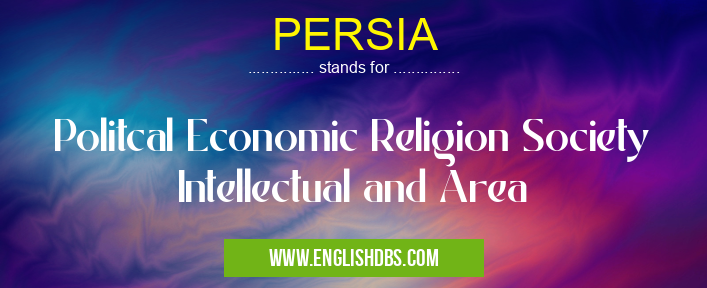What does PERSIA mean in
PERSIA is an acronym that represents various aspects of a region known historically as Persia, now modern-day Iran. It encompasses political, economic, religious, social, intellectual, and geographical elements.

PERSIA meaning in in Governmental
PERSIA mostly used in an acronym in Category Governmental that means Politcal Economic Religion Society Intellectual and Area
Shorthand: PERSIA,
Full Form: Politcal Economic Religion Society Intellectual and Area
For more information of "Politcal Economic Religion Society Intellectual and Area", see the section below.
» Governmental »
Politcal (Governmental)
- Political System: Persia has a long history of diverse political systems, from ancient monarchies to the current Islamic Republic.
- Governance: The government is headed by a Supreme Leader and consists of a parliament, judiciary, and executive branches.
- Foreign Policy: Persia has historically played a significant role in regional and global affairs, often as a bridge between East and West.
Economic
- Natural Resources: Persia is rich in natural resources, including oil, gas, and minerals.
- Economic Sectors: The economy is based on both traditional industries (agriculture, tourism) and modern sectors (energy, manufacturing).
- Trade: Persia has a long history of international trade, connecting it to markets in the Middle East, Asia, and Europe.
Religion
- Majority Religion: Islam (Shia) is the majority religion in Persia, deeply influencing its culture and society.
- Religious Diversity: Despite its predominantly Muslim population, Persia has historically been home to diverse religious groups, including Zoroastrians, Jews, and Christians.
- Religious Tolerance: While there have been periods of religious persecution, Persia has also exhibited a degree of religious tolerance throughout its history.
Society
- Cultural Identity: Persians have a rich and distinct cultural identity, shaped by their history, language, and traditions.
- Social Structure: Persian society is traditionally hierarchical, with a strong emphasis on family and community.
- Education: Persia has a long history of education and scholarship, with renowned universities and institutions of higher learning.
Intellectual
- Literature: Persia has a rich literary tradition, producing some of the most celebrated works in world literature, including the Shahnameh and the Rubaiyat of Omar Khayyam.
- Philosophy: Persian philosophers, such as Avicenna and Abu Nasr al-Farabi, have made significant contributions to Islamic philosophy.
- Science and Technology: Persia has a long history of scientific and technological advancements, including innovations in astronomy, mathematics, and medicine.
Area
- Geographical Location: Persia, now modern-day Iran, is located in Southwestern Asia, bordered by the Caspian Sea to the north and the Persian Gulf to the south.
- Land Area: Persia covers an area of approximately 1.6 million square kilometers, making it one of the largest countries in the Middle East.
- Climate: Persia experiences a diverse climate, with arid and semi-arid regions as well as mountainous areas with cooler temperatures.
Essential Questions and Answers on Politcal Economic Religion Society Intellectual and Area in "GOVERNMENTAL»ECONOMY"
What is Persia?
Persia is a historical region that corresponds to present-day Iran. It was home to one of the world's oldest and most influential civilizations.
What was the political system of Persia?
Persia was ruled by a powerful monarchy for most of its history. The king, known as the Shah, held absolute power and was advised by a grand vizier.
What was the economic system of Persia?
Persia had a strong economy based on agriculture, trade, and manufacturing. The main crops were wheat, barley, and fruits. Persia also produced fine textiles, carpets, and metalwork.
What was the religion of Persia?
Persia was predominantly Zoroastrian, an ancient religion based on the teachings of the prophet Zoroaster. Zoroastrianism emphasizes the importance of good thoughts, words, and deeds.
What was the society of Persia like?
Persian society was hierarchical, with the king at the top. Below the king were nobles, priests, soldiers, farmers, and slaves. Women had limited rights and were generally subordinate to men.
What were the intellectual achievements of Persia?
Persia made significant contributions to science, mathematics, and astronomy. Persian scholars developed algebra, trigonometry, and the concept of zero. They also made advances in medicine and philosophy.
Final Words: PERSIA is an acronym that encompasses the diverse aspects of a region with a rich history and culture. It provides a comprehensive understanding of Persia's political, economic, religious, social, intellectual, and geographical characteristics.
